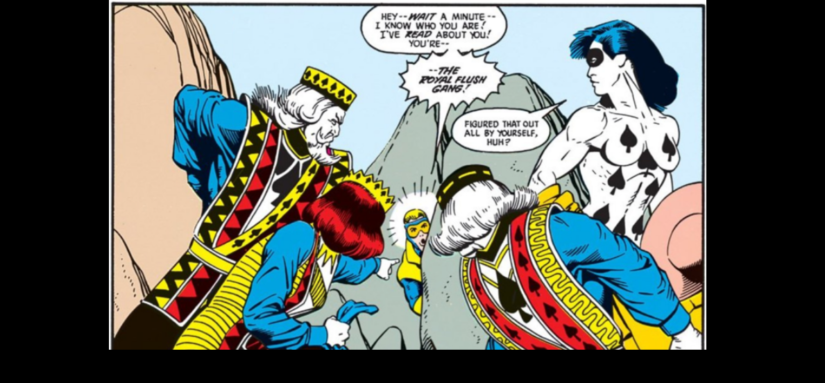On the last installment of Guy Gardner Has a Bowl Cut, we saw 1987’s Justice League sit down for their “Here’s how it’s gonna be” board meeting. It didn’t go well. Everyone hates Guy, Guy attacks everyone, everyone attacks back, Guy’s haircut makes him look like the bodily appendage that he acts like – it was a whole thing. For this time, we’re skipping ahead a few issues into the J. M. DeMatteis / Keith Giffen / Kevin Maguire run to see how everyone is getting along now that they’ve been together for a bit. And remember… I’m going in fresh, never having read any of this before.
This issue is very Booster Gold heavy, which makes me think… of all the classic comics I’ve covered, this early appearance of the character is the very first time I’ve written about him for Blastoff. Let’s not get ahead of ourselves though, because we have to talk about that cover.
We start the comic out in a way that, as a former Zenescope staff writer, I’m quite familiar with.
A double butt shot.
That’s a very, very bold move and I respect it. I do wonder… is the blue guy in the foreground supposed to be the Ace Android that Booster battles in the climax of this issue? That character was chalk white, but I can’t see who else this can be. I’m thinking maybe he was colored blue to pop on the cover, but that stands out as an odd choice to me because the Ace Android’s design is pretty creepy, intimidating, and memorable as is.
So, this is a pretty straightforward story this time around, with a lot more action. The set-up is that Maxwell Lord has been tricking heroes like Dr. Light and Booster Gold into thinking he has a connection with the Justice League. He essentially promises them that he’ll make them new members, and even breaks through the security systems – which annoys Batman to no end. Guy Gardner, who is never not looking for a new way to undercut his teammates, is more annoyed that they’re wasting time talking about it. He’d rather play bad cop with Lord… but for now, Batman wants to play it nice and ask questions. You know, intimidate with foreboding glares and vague threats rather than, as Guy Gardner suggested, torture the man.
Booster is hanging back, embarrassed as he watches all this go down. Feeling manipulated by Maxwell Lord and insulted by the Justice League, who are understandably skeptical because of the manner in which Booster was introduced, Booster splits. As soon as he leaves, the League’s security is brought down again (come on, guys) and the Royal Flush Gang attacks.
Now, the battle is by far the most interesting thing here. Booster Gold quips throughout the entire exchange, in a way that feels much more like modern comics than the comics of this time. Even in the late 80s, I’m more used to dialogue and captions explaining the powers, almost as if talking directly to the readers – but Booster, instead, is hitting his enemies with puns, one-liners, and self-deprecating humor. Now, I’m no comics historian (see your friendly neighborhood Tipton for that), but this feels to me like this must be an influential run. If you read comics before this, you get largely what I described. If you get superhero comics after this, to paint with a broad brush stroke, you’re basically looking at grim-dark reinventions inspired by Alan Moore and Frank Miller, or humorous characters who quip as much as they punch. I’m not sure who else was doing this at the time, but that immediately stood out to me as unique in the offerings I’ve covered from the 80s, less in the existence of the quips but more in the self-aware style.
Now, I haven’t read the preceding or following issue, so I might be missing something – but it seems very clear to me that Maxwell Lord orchestrated the events of this issue to get Booster Gold onto the Justice League. Booster Gold tells them that Maxwell Lord, who is with them, has a “Master plan” involving getting Booster onto the League. The compound is immediately attacked just as Booster is walking out, Booster battles the attackers and triumphs… and we’re supposed to believe the greatest detective in the world isn’t suspicious of the timing here? It’s a funny issue and the dialogue is very interesting, making this a book that certainly stands out from other superhero books of its time, but the plot seems pretty flimsy. For a story that hinges so strongly on character, I find it jarring that Batman and the entirety of the Justice League lack the strategic intelligence and battle-savvy that we normally see them display in other books.
Overall, I’m having fun through this run but even as a very casual fan of this era of superhero comics, the characterization here has yet to grab me. If half the jokes that are just “Guy Gardner is a douche” were cut down, there would be about five more pages of room to add nuance to the other characters… and Guy Gardner would still be a douche. I can see how the dialogue style of this book is influential, which makes it an interesting read in 2018, so I’m looking forward to seeing how issues later in the run feel once this team gels with the characters more.
NEXT: Full speed ahead to Justice League #5.





Comments are closed.